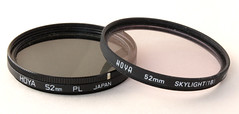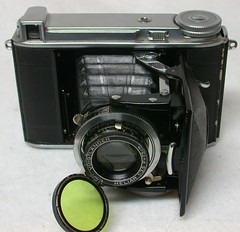Difference between revisions of "Filter"
(image added) |
m (both pics CP -> CW; attribution & rights into template) |
||
| Line 1: | Line 1: | ||
{{glossary}} | {{glossary}} | ||
| + | {{stub}} | ||
{{Flickr image | {{Flickr image | ||
| − | | image_source=http://www.flickr.com/photos/awcam/3913174002/in/pool- | + | | image_source=http://www.flickr.com/photos/awcam/3913174002/in/pool-camerawiki |
| image=http://farm4.static.flickr.com/3445/3913174002_9fe56e6827_m.jpg | | image=http://farm4.static.flickr.com/3445/3913174002_9fe56e6827_m.jpg | ||
| image_align=left | | image_align=left | ||
| − | | image_text=Polarising and Skylight filters<br />for 52mm [[filter thread]] fitting | + | | image_text=Polarising and Skylight filters<br />for 52mm [[filter thread]] fitting |
| + | |image_by=AWCam | ||
| + | |image_rights=wp | ||
}} | }} | ||
A '''filter''' is an optical device that can be added to the optical system of a [[camera]]. It consists of one or two glass (or, more recently, plastic or gelatine) plates, mounted in a frame that is attachable to the lens of a camera. Attachment may be by a push-fit, a bayonet fitting, or to the [[filter thread]] of a lens, or the filter may be built-in to the camera. | A '''filter''' is an optical device that can be added to the optical system of a [[camera]]. It consists of one or two glass (or, more recently, plastic or gelatine) plates, mounted in a frame that is attachable to the lens of a camera. Attachment may be by a push-fit, a bayonet fitting, or to the [[filter thread]] of a lens, or the filter may be built-in to the camera. | ||
| Line 10: | Line 13: | ||
Colour filters let through light of a certain colour better than light of other colours. Early colour filters were cuvettes which could be filled with coloured water. Nowadays color filters consist of only one glass plate which is coated with a transparent glass color. | Colour filters let through light of a certain colour better than light of other colours. Early colour filters were cuvettes which could be filled with coloured water. Nowadays color filters consist of only one glass plate which is coated with a transparent glass color. | ||
{{Flickr image | {{Flickr image | ||
| − | | image_source=http://www.flickr.com/photos/mfobrien/2227904336/in/pool- | + | | image_source=http://www.flickr.com/photos/mfobrien/2227904336/in/pool-camerawiki |
| image=http://farm3.static.flickr.com/2251/2227904336_81a8020be4_m.jpg | | image=http://farm3.static.flickr.com/2251/2227904336_81a8020be4_m.jpg | ||
| image_align=right | | image_align=right | ||
| − | | image_text=[[Bessa 66|Voigtländer Bessa]] with hinged yellow filter | + | | image_text=[[Bessa 66|Voigtländer Bessa]] with hinged yellow filter |
| + | |image_by=Mark O'Brien | ||
| + | |image_rights=wp | ||
}} | }} | ||
In black-and-white photography, coloured filters can be used, e.g. to improve modelling of skin tones (green or yellow-green filters), or to darken washed-out skies and show cloud detail (e.g. yellow filter). Many [[box camera|box-type cameras]] - and some more sophisticated models - had built-in yellow or green filters for these purposes. | In black-and-white photography, coloured filters can be used, e.g. to improve modelling of skin tones (green or yellow-green filters), or to darken washed-out skies and show cloud detail (e.g. yellow filter). Many [[box camera|box-type cameras]] - and some more sophisticated models - had built-in yellow or green filters for these purposes. | ||
| Line 21: | Line 26: | ||
[[Neutral Density filter]]s (ND filters) merely reduce the level of light, without changing the colour. | [[Neutral Density filter]]s (ND filters) merely reduce the level of light, without changing the colour. | ||
| − | + | ||
[[Category: Camera parts]] | [[Category: Camera parts]] | ||
[[Category: Lens accessories]] | [[Category: Lens accessories]] | ||
Revision as of 20:12, 21 October 2011

|
| Polarising and Skylight filters for 52mm filter thread fitting image by AWCam (Image rights) |
A filter is an optical device that can be added to the optical system of a camera. It consists of one or two glass (or, more recently, plastic or gelatine) plates, mounted in a frame that is attachable to the lens of a camera. Attachment may be by a push-fit, a bayonet fitting, or to the filter thread of a lens, or the filter may be built-in to the camera.
Colour filters let through light of a certain colour better than light of other colours. Early colour filters were cuvettes which could be filled with coloured water. Nowadays color filters consist of only one glass plate which is coated with a transparent glass color.

|
| Voigtländer Bessa with hinged yellow filter image by Mark O'Brien (Image rights) |
In black-and-white photography, coloured filters can be used, e.g. to improve modelling of skin tones (green or yellow-green filters), or to darken washed-out skies and show cloud detail (e.g. yellow filter). Many box-type cameras - and some more sophisticated models - had built-in yellow or green filters for these purposes.
Special types of filters include skylight - which blocks Ultra-Violet (and so improves colour rendering), and polarising - which lets through only light vibrating in a particular plane and can be used to block glare. Effects - such as soft-focus and "sparkling" highlights - can also be produced using special types of filter.
Neutral Density filters (ND filters) merely reduce the level of light, without changing the colour.